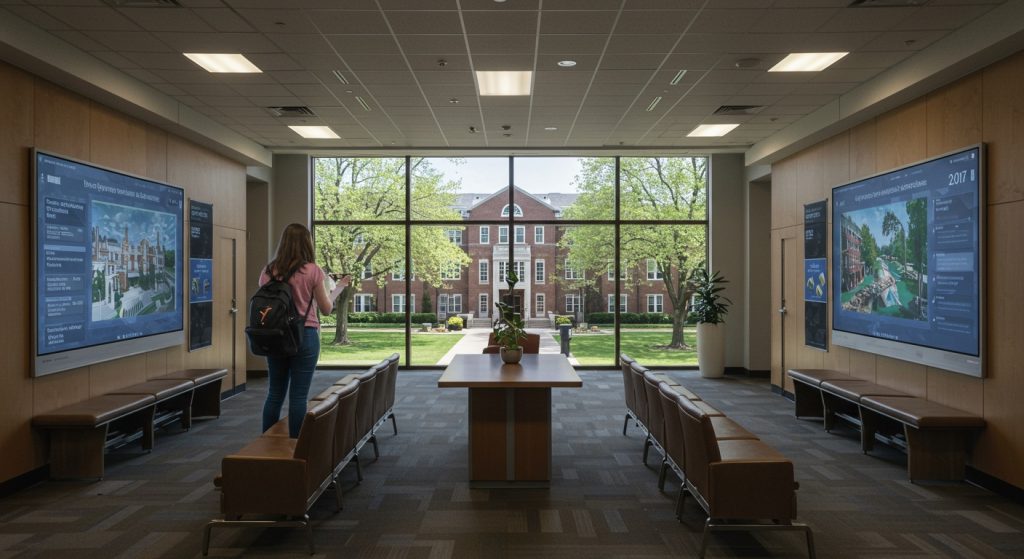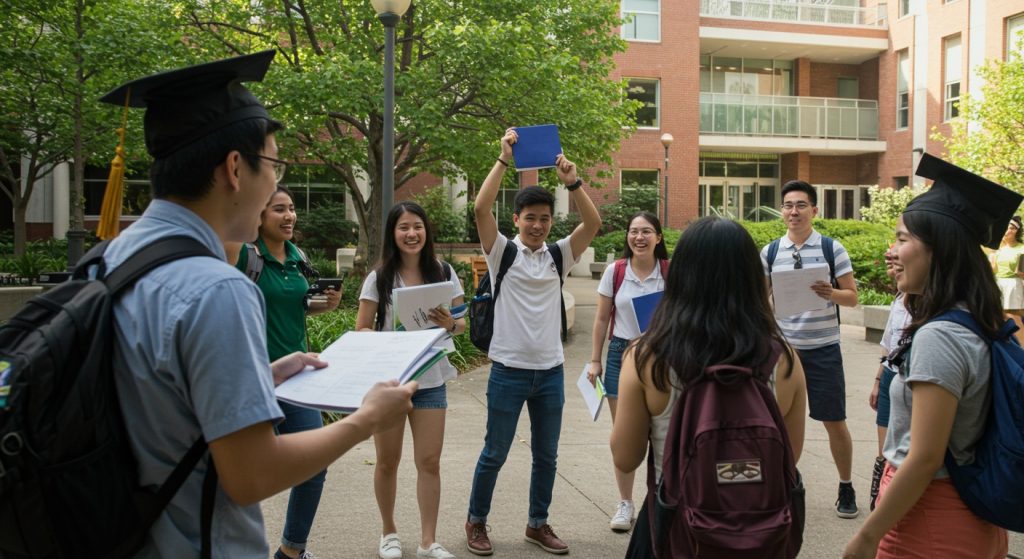Navigating the complex university application landscape often feels like a competitive marathon, especially with the surging demand for specialized degrees in areas like AI engineering and sustainable development. Many prospective students overlook a powerful strategy: direct university admission. This expedited pathway, increasingly offered by institutions adapting to global talent shortages and the need for immediate skill integration, allows focused individuals to bypass conventional bottlenecks, securing their place in high-demand programs without the protracted wait. Consider how bypassing a year of general studies could accelerate your entry into a burgeoning field, placing you ahead of peers in the race for crucial internships and early career opportunities. Understanding these direct routes offers a significant strategic advantage in today’s fiercely competitive educational and professional arenas.

Understanding Direct University Admission: A Clear Path Forward
Direct university admission, often referred to as direct entry or guaranteed admission, is a pathway that allows eligible students to secure a spot at a university without going through the traditional, often lengthy, application processes that involve multiple rounds of interviews, extensive essays. Competitive selection stages. Instead, students might be admitted based on meeting specific academic criteria (e. G. , a certain GPA, standardized test scores, or specific subject achievements), participation in feeder programs, or through specific partnerships between high schools and universities. Think of it as a fast-track lane designed to recognize and reward academic excellence or specific program alignments early on. This differs significantly from the conventional application process where students typically apply to multiple institutions, submit various documents, write personal statements, obtain letters of recommendation. Then wait for several months for a decision. Direct Admission Options streamline this, offering clarity and certainty much sooner.
The Streamlined Application Process: Simplicity at Its Best
One of the most compelling advantages of direct university admission is the significantly streamlined application process. Gone are the days of juggling multiple application portals, remembering different deadlines. Tailoring countless essays.
- Fewer Forms, Less Hassle: Often, direct admission involves a simpler application form or even automatic consideration if you meet the pre-defined criteria. This means less paperwork and fewer opportunities for errors.
- Reduced Bureaucracy: The administrative burden on students and their families is dramatically lessened. You’re not navigating a complex web of requirements; instead, you’re meeting clear, upfront qualifications.
- Focused Effort: Instead of spreading your energy across numerous applications, you can focus on excelling in your current studies knowing that your hard work directly translates to a university spot.
For instance, many universities offer direct admission to students from partner high schools who maintain a certain GPA in specific subjects. This partnership simplifies the entire process for both the student and the university, leading to a more efficient and less stressful experience.
Faster Decision Making: Certainty Sooner
The waiting game for university admission decisions can be one of the most stressful periods for students and their families. Direct admission drastically cuts down this waiting time, providing much-needed certainty earlier in the academic year.
- Early Offers: Students often receive their admission offers much earlier than those going through traditional routes. This can happen even in their junior or early senior year of high school.
- Reduced Anxiety: Knowing where you’ll be studying well in advance alleviates immense pressure. This allows students to focus on finishing high school strong, rather than worrying about their future.
- Planning Ahead: With an early admission decision, you can start planning your university life sooner – from choosing courses to exploring housing options and even looking for part-time jobs or scholarships specific to your admitted program.
Consider Sarah, a student who secured direct admission to her dream engineering program based on her stellar performance in STEM subjects. While her friends were still anxiously checking their email for admission updates in spring, Sarah was already researching dorm room layouts and planning her first-year courses. This early certainty empowered her to enjoy her final year of high school without the looming stress of applications.
Reduced Stress and Uncertainty: A Calmer Journey
The psychological benefits of direct university admission cannot be overstated. The traditional application cycle is notorious for high levels of stress, anxiety. Uncertainty for students and their families.
- Peace of Mind: Knowing you have a guaranteed spot significantly reduces the mental burden. You can enjoy your final year of high school, participate in extracurriculars. Prepare for university life without constant worry.
- Emotional Well-being: This reduction in stress positively impacts a student’s emotional and mental health, allowing them to perform better in their current studies and approach the transition to university with a positive mindset.
- Family Relief: Parents also experience significant relief, as the financial and logistical planning for higher education becomes clearer and more predictable.
“The constant ‘what if’ factor was draining,” shared Mark, a student who benefited from direct admission to a competitive business program. “Once I got that offer, it felt like a huge weight lifted. I could actually focus on my classes and enjoy my senior year.” This personal account highlights the profound impact of certainty on a student’s well-being.
Cost and Time Savings: Smart Investment in Your Future
Beyond the emotional benefits, direct university admission can also lead to tangible cost and time savings.
- Lower Application Fees: Many universities waive application fees for direct admission candidates or for specific Direct Admission Options programs, saving students hundreds of dollars if they were applying to multiple institutions.
- Reduced Travel Costs: Without the need for multiple campus visits for interviews or specific recruitment events, families can save on travel, accommodation. Related expenses.
- Earlier Career Entry: For some programs, particularly those with a clear career path, early admission might mean an earlier start to your higher education journey, potentially leading to earlier graduation and entry into the workforce. This translates to more earning potential over your lifetime.
This pathway allows students to allocate resources more effectively, whether it’s saving money for tuition, textbooks, or simply investing in experiences that enrich their pre-university life.
Early Access to Resources and Community: Getting a Head Start
Directly admitted students often gain access to university resources and communities much earlier than their peers.
- Priority Registration: Some direct admission programs offer priority registration for courses, allowing students to secure their preferred classes and build a suitable academic schedule.
- Housing Preferences: Early admits might also get preferential treatment in university housing selection, securing better dorms or specific living-learning communities.
- Orientation Programs: Many universities offer special orientation sessions or early access to online resources specifically for their direct admit cohort, helping them integrate into the university environment smoothly.
- Networking Opportunities: Connecting with future classmates and faculty members early on can provide a significant advantage, building a support network before classes even begin.
This early engagement fosters a sense of belonging and helps students feel more prepared and confident as they transition from high school to university life.
Tailored Support and Guidance: A Personalized Approach
Universities are increasingly recognizing the value of supporting their direct admit students, often providing tailored guidance.
- Dedicated Advisors: Some programs assign dedicated academic advisors or mentors who can help navigate course selection, academic planning. Career pathways even before matriculation.
- Specialized Workshops: Universities might offer workshops or seminars exclusively for direct admits, covering topics like study skills, time management, or introduction to research.
- Mentorship Programs: Opportunities to connect with current university students or alumni who went through the same direct admission process can provide invaluable insights and support.
This personalized approach ensures that direct admit students are not just given a spot. Are also set up for success from day one, reflecting a university’s commitment to their future.
Enhanced Focus on Academics: Maximizing Your Potential
With the stress of applications removed, students can redirect their energy and focus entirely on their academic performance in high school.
- Improved Grades: Without the pressure of constantly refining essays or preparing for interviews, students can dedicate more time to their coursework, potentially leading to higher grades.
- Deeper Learning: This allows for a deeper engagement with subjects, fostering genuine intellectual curiosity rather than just studying for tests.
- Exploration: Students might feel more empowered to take challenging courses or explore new academic interests without worrying about how it will look on a university application.
This enhanced focus not only helps them finish high school strong but also builds a solid academic foundation for their university studies.
Real-World Impact: Stories of Success
Let’s look at a couple of scenarios where Direct Admission Options made a significant difference:
Case Study 1: The Aspiring Doctor
Maria had her sights set on becoming a doctor. Many medical schools offer “BS/MD” or “Direct Medical Program” pathways, which are essentially direct admission programs. Maria applied to one such program in her junior year of high school. By early senior year, she received a conditional offer of admission, contingent on maintaining a specific GPA and taking certain prerequisite courses. This meant she didn’t have to stress about the highly competitive standard medical school application process later on, which involves the MCAT exam, multiple rounds of interviews. A prolonged waiting period. This certainty allowed her to focus on excelling in her science courses, volunteering at a local hospital. Pursuing research opportunities, all of which strengthened her foundation for medical school.
Case Study 2: The Tech Innovator
David was a coding prodigy in high school. A forward-thinking university, known for its strong computer science program, offered a direct admission pathway for students who demonstrated exceptional aptitude in programming competitions and maintained high grades in advanced math and science. David submitted his portfolio of coding projects and his academic transcript. He received his admission offer by December of his senior year. While his peers were still crafting essays for various tech programs, David was already collaborating with university professors on a side project, attending early workshops on cutting-edge AI. Even secured an early internship opportunity through the university’s network. This head start was invaluable for his career trajectory.
Comparison: Direct vs. Traditional Admission
To further clarify the benefits, here’s a comparison of direct versus traditional university admission.
| Feature | Direct University Admission | Traditional University Admission |
|---|---|---|
| Application Complexity | Generally simpler, fewer forms, clear criteria. | Often complex, extensive forms, essays, recommendations. |
| Decision Timeline | Early and fast (often junior/early senior year). | Later (typically spring of senior year), prolonged waiting. |
| Stress Level | Significantly reduced uncertainty and anxiety. | High stress due to competition and waiting. |
| Cost Implications | Potentially lower application fees, travel savings. | Higher cumulative application fees, potential travel for interviews. |
| Access to Resources | Often early access to orientation, course selection, housing. | Access typically begins after full admission and commitment. |
| Focus during High School | Can focus purely on academics and personal growth. | Often divided between academics and application tasks. |
| Certainty | High degree of certainty early on. | Uncertainty until decisions are released. |
Actionable Takeaways: How to Explore Direct Admission Options
If the benefits of direct university admission resonate with you, here are some actionable steps you can take to explore these pathways:
- Research Early: Start researching universities and their admission policies as early as your freshman or sophomore year of high school. Look specifically for “direct entry,” “guaranteed admission,” “early assurance,” or “feeder program” on their admissions websites.
- grasp Criteria: Pay close attention to the specific academic criteria (GPA, test scores, specific courses) and any non-academic requirements (extracurriculars, essays) for direct admission programs.
- Talk to Your Counselor: Your high school guidance counselor is an invaluable resource. They often have insights on Direct Admission Options, partnerships with universities. Can help you identify programs that align with your profile.
- Contact University Admissions: Don’t hesitate to reach out directly to the admissions offices of universities you’re interested in. Ask specific questions about direct admission pathways for your intended major.
- Maintain Strong Academics: The most common requirement for direct admission is a strong academic record. Focus on excelling in your coursework, especially in subjects relevant to your desired field of study.
- Participate in Relevant Extracurriculars: Some direct admission programs, particularly in specialized fields like arts or STEM, might consider your portfolio, competition results, or leadership in relevant clubs.
- Consider Specialized Programs: Look into combined degree programs (e. G. , BS/MD, BA/JD) or specialized academies that often have their own direct admission criteria.
Conclusion
You’ve seen how direct university admission empowers you to take charge of your educational journey, fostering transparency, saving costs by bypassing intermediaries. Providing immediate access to accurate data. This shift towards direct engagement is a notable current trend, with many universities streamlining their own application portals, making the process more accessible than ever before. For instance, you can now clarify specific program prerequisites or scholarship opportunities directly with the admissions office, eliminating potential misinterpretations often found in third-party channels. My personal tip? Don’t hesitate to reach out directly to university admissions teams with any questions – their primary goal is to help you succeed. Initiating that direct communication early can build a valuable rapport. This proactive approach ensures you receive real-time updates and personalized guidance, a crucial advantage in the competitive application landscape. Embrace this direct pathway; it’s not just about securing a spot. About confidently stepping into your future, fully informed and empowered.
More Articles
Career Focused: Choosing the Right State University for Your Future Goals
Ace Your Application: State University Requirements You Must Know for 2025
Smart Budgeting: Comparing State University Tuition Fees For In-State Students
Find Your Path: How to Choose a College Major That Fits You
FAQs
What’s the biggest perk of applying directly to a university?
One of the top benefits is how straightforward and simple it is. You often bypass complex application portals and deal directly with the university’s admissions team, making the whole process much quicker and less confusing.
Will I hear back faster if I apply direct?
Absolutely! Direct admission often means a much quicker decision timeframe. This reduces the anxious waiting period and lets you know where you stand sooner, helping you plan your future without delay.
Is it really easier to get in with direct admission?
In many cases, yes. Direct admission typically has very clear and transparent requirements. If you meet the academic criteria, such as a specific GPA or test score, your admission is often more or less guaranteed, cutting down on uncertainty.
How does direct admission help me focus on my studies?
By streamlining the application process, direct admission frees up valuable time and mental energy. Instead of wrestling with multiple forms and deadlines, you can dedicate more attention to your current academic performance and prepare better for university life.
Are there any financial benefits to direct applications?
Potentially, yes. Some direct admission pathways might waive application fees that are common with more complex application systems. Plus, saving time on applications means more time for earning or focusing on scholarships.
What are the advantages for planning my university journey early?
Getting an early acceptance through direct admission provides immense peace of mind. You can start planning for accommodation, financial aid. Even course selections much sooner, giving you a head start on preparing for your future.
Can I get better support from the university if I apply directly?
Yes, often. When you apply directly, you’re interacting directly with the university’s admissions team. This can lead to more personalized support and clearer communication regarding your application status and any questions you might have, rather than going through a third-party system.



